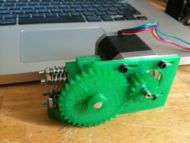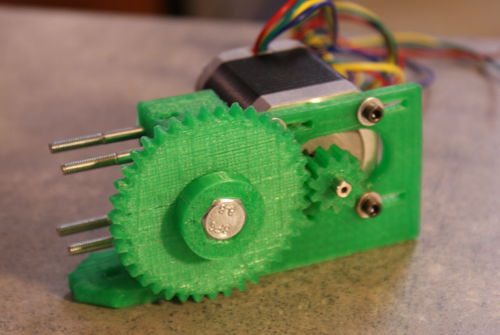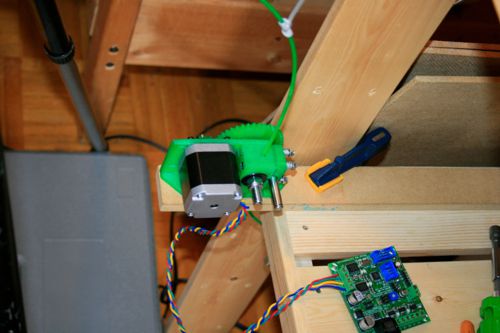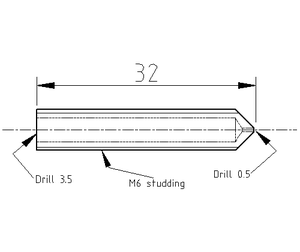Wade's Geared Extruder
|
English • العربية • български • català • čeština • Deutsch • Ελληνικά • español • فارسی • français • hrvatski • magyar • italiano • română • 日本語 • 한국어 • lietuvių • Nederlands • norsk • polski • português • русский • Türkçe • українська • 中文(中国大陆) • 中文(台灣) • עברית • azərbaycanca • |
Release status: Working
| Description | Geared Nema 17 Extruder
|
| License | GPL
|
| Author | |
| Contributors | |
| Based-on | |
| Categories | |
| CAD Models | |
| External Link |
This work is based on Adrian's Geared Nema 14 extruder (Adrian's Geared Extruder) design, and includes many concepts lifted from Nophead's extruder (Nophead's Extruder Tweaks) research.
This extruder was designed for the RepRap Sells Mendel (but will work with about any 3D printer, if with adaptors) and is robust, provides a strong force to extrude, is cheap and DIY. It is an alternative to the Geared Nema17 Extruder Driver and has the following advantages:
- no need to buy/use expensive metal gears;
- no need to do two precision flats on motor shaft;
- no need to glue the PTFE barrel;
Other advantages over other extruders are:
- extrude/print at high speed;
- good for use with a low torque/cheap Nema 17 motor ; (Needs verification)
- no need to use expensive and complex tools - just one hand drill, a file and a M4 or M5 tap;
- no need to make splines on motor shaft;
Contents
How to get it
While this design is made with DIYers in mind, if you can't make your own, or simply don't want to, you can always buy one. There are users printing it and selling on Ebay.
Mechanical Construction
To access assembly into CAD, visit Onshape or GrabCAD
Materials
Printed Parts
| Quantity | Description | Type | Comments | Diagram |
|---|---|---|---|---|
| 1 | extruder block | RP | File:M8 Extruder 3.zip | |
| 1 | extruder idler block | RP | File:M8 Extruder 3.zip | |
| 1 | 11 tooth drive gear | RP | File:M8 Gears.zip | |
| 1 | 39 tooth M8 hub driven gear | RP | File:M8 Gears.zip | 
|
Non-Printed Parts
| Quantity | Description | Type | Comments |
|---|---|---|---|
| Feeder | |||
| 2 | 608 bearings, skateboard bearings | Bearings | |
| 1 | M8×50 bolt | Fastener | to be hobbed, M8×60 has a longer smooth part, allows a second lock-nut, and may be easier to find |
| 1 | M8 nut | Fastener | Nyloc works better, but a pair of nuts will also work |
| 4-5 | M8 washers | Fastener | to space the large gear clear of the motor retaining bolt heads. Some designs and kits use a printed spacer. |
| Idler | |||
| 1 | 608 bearing, skateboard bearing | Bearings | |
| 1 | (M)8×20 | Threaded rod | |
| 4 | M4×60 or M4×45 hex head bolts | Fastener | Hex head will work best (they won't turn), and longer than 45 mm will be easier to assemble if you can find them. |
| 4 | M4 nuts | Fastener | typically wing nuts |
| 8 | M4 washers | Fastener | |
| 4 | ~4mm ID springs | Spring | Sized to fit over an M4 bolt, unsprung length of 10-12mm, each spring providing 25-35N load. For a given filament drive force, you'll need about twice the spring force - i.e., if you want 100N of filament drive, your springs need to push with about 50N each. |
| 16 | M4 washers | Fastener | optional; 4 washers on each M4X45 idler bolt between the main block and the idler block will limit the idler travel and make reloading filament easier. |
| NOTE: Some users have their extruders working without springs, but springs are recommended. A good source for these springs is in the cloth-cabinet on spring loaded skirt-hangers or trouser-hangers. Just cut the right length off the springs. | |||
| Hot End Mount | |||
| 2 | M3×35 bolts | Fastener | |
| 4 | M3 washers | Fastener | |
| 2 | M3 nuts | Fastener | |
| 1 | 2.5mm drill | See section Hot End | |
| Stepper Motor Mount | |||
| 3 | M3×10 bolts | Fastener | Low profile bolt heads might work better here |
| 3 | M3 washers | Fastener | |
| 1 | M3 grub screw | Fastener | To secure the pulley, ideally 8mm long, but anything 6mm+ should be fine |
| 1 | M3 nut | Fastener | To secure the pulley |
| Stepper Motor | |||
| 1 | NEMA 17 bipolar stepper motors | Stepper | 0.49 Nm (69 ozf*in) works well; Kysan 42BYGH4803 is what I used. Should be capable of creating a holding torque of at least 0.4Nm (56.6 ozf*in), at the very least. |
| Extruder Mount | |||
| 2 | M4×20 bolts | Fastener | |
| 2 | M4 nuts | Fastener | |
| 2 | M4 washers | Fastener | |
Assembly instructions
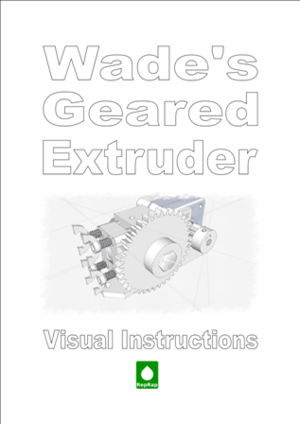
Inserting the short rod into the bearing to make the idler is easy if using a threaded rod. If using a smooth rod, it can be a tight fit. It is necessary to ensure that the cut ends of the rod are well finished, preferably with a slight chamfer (using a hand file) to guide it into the bearing. Careful use of a vice can then press the rod into place, with washers being used to get it past the end of the bearing to the middle.
The Hobbed Bolt
On how to make a Hobbed Bolt, see Making a Hobbed Bolt. That done, mount it like this:
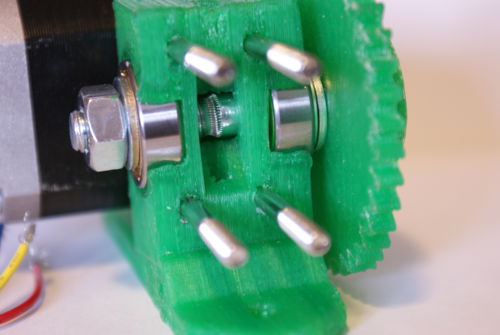
|
- Note 1 - I prefer to use a Nylock nut on the end of the M8 shaft. Locktite should work as well, or a longer bolt with two nuts.
So far so good! If you add 3 or 4 M4 washers on each bolt before you put the idler block on, it will reduce the idler block travel when loading new filament, making loading new filament much easier.
Here's the test jig:
This extruder hit 16 kg - here's the results: M8 shoulder bolt - 7.0kg, adjusted tension, new springs - 11.0 kg,
Tightened springs, 3 trials:
15.5 kg, 16.5 kg, 15.25 kg
The final failure mode was the stepper running in reverse, as opposed to the filament slipping. That's quite promising.
The Hot End Mount
Attach a length of 16 mm PTFE using the two M (M3x35?) bolts to pin it in place. The holes in the ABS motor mount are 2.3mm diameter and are designed for thread-forming after being drilled to 2.5mm (2.3mm is very tight for M3 - M3's have a 2.387 bolt diameter and must be pre drilled 2.5mm for thread-cutting and even drilled wider for thread-forming, but plastic is very soft Threadinfo).
According to Nophead the holes should be drilled to 2.5mm, then you should insert the PTFE Insulator and drill a 2.5mm hole through both using the ABS part as guide. After the first hole is done insert a nail or second drill into the existing first hole to lock the teflon cylinder in place and prevent it from turning. After that use a M3 to thread-form the thread (one could also try to use a M3 tap drill (thread-cutter) and finish the mount, but thread-forming will do). The Teflon is very soft so it is very easy to thread-form. In the end the extruder should fit tightly.
Wade suggests that the nozzle can be built straight and is screwed into the PTFE (Teflon) cylinder from the bottom. There is no need for a PEEK bar or extra screws to hold the nozzle to the carriage.
Nophead's opinion is that unsupported PTFE may be OK for PLA but not for the higher temperatures and pressures ABS needs. He recommends a PEEK insulator with a PTFE liner or an external support which would need an adapter plate.
I use 8mm od brass rod, with a 4 mm ID melt chamber, insulated nichrome wire and furnace cement to hold it all together.
3D CAD Files
Here's the design files for the latest version:
- extruder body and idler block: File:M8 Extruder 3.zip
- 11 tooth drive gear and 39 tooth M8 hub driven gear: File:M8 Gears.zip
- alternative 11 tooth gear that should be better: File:Nophead gear with setscrew for wade extruder.zip
- (if you do not want to use a vise to support the M8 bolt) use this support for bearings, needed when using M3 tap: File:Pinchwheelwormdrilljig.zip
- Horizontal Wade Mount by tbuser
- Alternative driven gear by GilesBathgate
- You can also get the files from thingiverse although they may not be the most recent.
Finally, here's a spreadsheet to help calculate the proper feedrates: media:feedrates.ods | media:feedrates.xls
An updated version of the spreadsheet to use with Skeinforge, somewhat simplified. I vary the layer thickness, width/thickness and the two speed settings until I get a density near unity for nicely solid solid parts: media:Extruder Calcs 2010.07.13.ods
Variations on this design
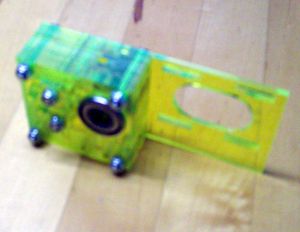
Alternative filament drive bolt: http://suddendevelopment.com/?p=68
Older versions
Here is a link to a previous version of this page that describes an earlier version of this extruder that uses an M4 shaft, and includes more details about pull testing the two versions: Geared_Nema17_Extruder_V0.5
